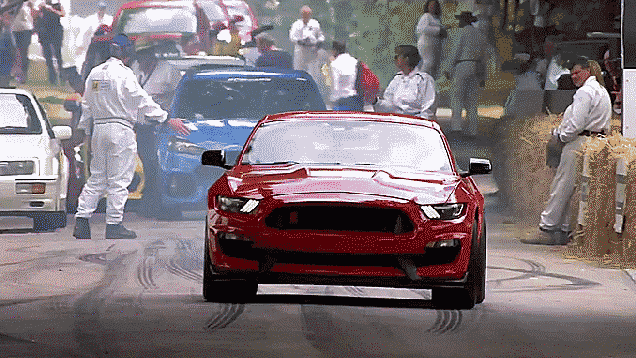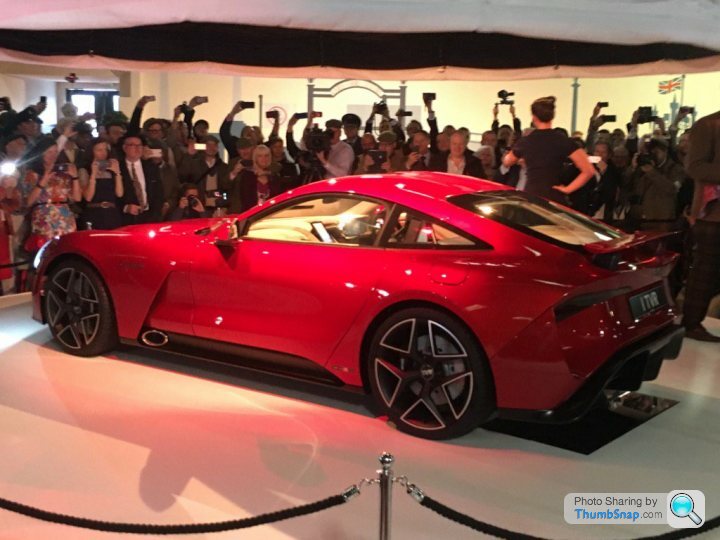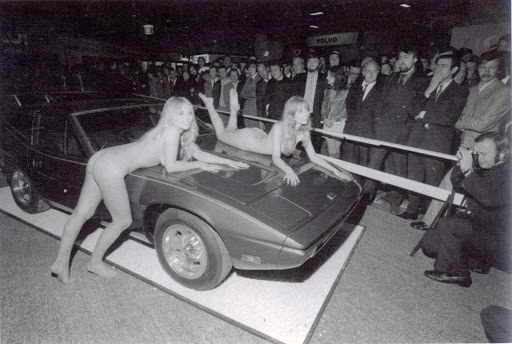New TVR confirmed
Discussion
msmith0592 said:
DonkeyApple said:
My basic understanding is that on Tivs the noise is caused by the MBE system running batch injection as it is simpler and cheaper. So fuel is basically dumped into the engine any old how 
Sequential injection is much more complex and expensive as it needs information from the cam shaft to know exactly which cylinder to prime and when. The demand for this obviously being recent emission rules and the race for mpg.
So sequential systems are more efficient on normal throttle loads and excess fuel isn't being dumped into the pipes so what a modern manufacturer has to do is tweak the EcU to throw some fuel in uneccasarily to get it to pop and bang.
At least with the TVR it wasn't deliberate but a by product of fitting cheaper and simpler engine management software whereas everything today has to be a deliberate marketing call programmed in to the computer to make.
Apparently the engineers wanted to map out the oops and bangs, however they were overruled by the marketing department.
Sequential injection is much more complex and expensive as it needs information from the cam shaft to know exactly which cylinder to prime and when. The demand for this obviously being recent emission rules and the race for mpg.
So sequential systems are more efficient on normal throttle loads and excess fuel isn't being dumped into the pipes so what a modern manufacturer has to do is tweak the EcU to throw some fuel in uneccasarily to get it to pop and bang.
At least with the TVR it wasn't deliberate but a by product of fitting cheaper and simpler engine management software whereas everything today has to be a deliberate marketing call programmed in to the computer to make.
Folks with the Syvecs sequential system have several map options, some with no pops and bangs, some that sound like a gun battle.
 . It's all down to the mapping. Really the only engines that do it "naturally" are carb fed, essentially because of a comparative lack of control over the fuel/air mix flow.
. It's all down to the mapping. Really the only engines that do it "naturally" are carb fed, essentially because of a comparative lack of control over the fuel/air mix flow.PoleDriver said:
It is also the case that opening the inlet valve before the exhaust valve closes aids with clearing the cylinder of all exhaust gases thus leaving more space for petrol/air mixture which results in more efficient combustion!
This is what mine does (big cam), but it does mean it uses a lot of fuel... average on the road is about 19mpg... single figures on track... it's not economical, it stinks of fuel even on tickover, I can see the petrol gauge dropping.... But the noise... 
Wouldn't have it any other way

(doing my bit for the environment.... sooner we go electric the better)
I also love the bit in the last Bond film where he opens the garage door and the DB5 is sitting there... gave me goosebump hair on end thingys....

Oh if only I could afford ITB's

PoleDriver said:
It is also the case that opening the inlet valve before the exhaust valve closes aids with clearing the cylinder of all exhaust gases thus leaving more space for petrol/air mixture which results in more efficient combustion!
Which I believe in the old days was an effect known as scavenging i.e. using fuel to purge any remaining burnt gas from the combustion chamber. It also cools the exhaust valves. RichB said:
PoleDriver said:
It is also the case that opening the inlet valve before the exhaust valve closes aids with clearing the cylinder of all exhaust gases thus leaving more space for petrol/air mixture which results in more efficient combustion!
Which I believe in the old days was an effect known as scavenging i.e. using fuel to purge any remaining burnt gas from the combustion chamber. It also cools the exhaust valves. 
dvs_dave said:
Oh my! Just listen to said engine in the new Mustang GT350R run up the hill at the Goodwood FOS today. Truck engine????  GTFO!
GTFO!
https://youtu.be/jp9d-HhblD0

Looks like that RS200 in front had something to think about
If TVR can deliver something similar/equivalent to this (with TVR styling) in 2 years from now I will be so excited!!!  GTFO!
GTFO!https://youtu.be/jp9d-HhblD0

Looks like that RS200 in front had something to think about

Edited by dvs_dave on Friday 26th June 23:10
RichB said:
PoleDriver said:
It is also the case that opening the inlet valve before the exhaust valve closes aids with clearing the cylinder of all exhaust gases thus leaving more space for petrol/air mixture which results in more efficient combustion!
Which I believe in the old days was an effect known as scavenging i.e. using fuel to purge any remaining burnt gas from the combustion chamber. It also cools the exhaust valves. Good inlet and exhaust tuning along with the appropriate valve timing is still very important to this day when designing a high performance NA engine.
DonkeyApple said:
I think the real key will be designing a torque curve that allows the best application of the power. I always felt that the 5L Rover delivered it's torque in the wrong place over too short a range and it made the cars unnecessarily twitchy. Great fun but I never felt it evolved the driving experience on from their smaller cc engines.
 At some point, the Dutch importers stopped lending 500s to the press...
At some point, the Dutch importers stopped lending 500s to the press... 
dvs_dave said:
RichB said:
PoleDriver said:
It is also the case that opening the inlet valve before the exhaust valve closes aids with clearing the cylinder of all exhaust gases thus leaving more space for petrol/air mixture which results in more efficient combustion!
Which I believe in the old days was an effect known as scavenging i.e. using fuel to purge any remaining burnt gas from the combustion chamber. It also cools the exhaust valves. Good inlet and exhaust tuning along with the appropriate valve timing is still very important to this day when designing a high performance NA engine.
Exact same principles at play in modern engines, just what with them being able to vary the valve timing and have much better control of the fuel/air mix and ignition, the electronics are able to adjust the engine on-the-fly to suit the current operating conditions much better. Older engines with none of this gubbins were tuned to work best at a certain speed and load range. Because of the lack of dynamic adjustability of the system their operation suffers outside of that speed and load range usually manifesting itself as rough running, strong smelling exhaust fumes, pops and bangs and general recalcitrance, or "character" as us TVR owners like to call it. 
For example, throwing a "bigger" or "lumpier" cam in an old RV8 might get you more top end power, but the general drivability at other speed ranges will suffer as it's not able to adjust itself sufficiently to suit. Modern engines get around this whole "robbing Peter to pay Paul" situation with their considerable dynamic adjustability. Technically they're far superior, but the engine's character takes a hit instead. Everything is a trade off with engines

For example, throwing a "bigger" or "lumpier" cam in an old RV8 might get you more top end power, but the general drivability at other speed ranges will suffer as it's not able to adjust itself sufficiently to suit. Modern engines get around this whole "robbing Peter to pay Paul" situation with their considerable dynamic adjustability. Technically they're far superior, but the engine's character takes a hit instead. Everything is a trade off with engines

DonkeyApple said:
I agree 100% with that as well as Julian's remark about silent Porsche's and giggling fits in a TVR. A Boxster is an awesome car and the Cayman better still but to get a thrill from a set of corners on an English road means travelling simply too quickly to be prudent. Ignoring those who buy into Porsche for the kudos it is clear that the true enthusiasts buy such a car for a different set of parameters to why an enthusiast buys a TVR. There isn't an awful lot of crossover in reality.
I don't know about this really. I absolutely loved my Boxster S, it was fantastic fun to thrash about on country roads, could get a bit out of shape and still be alright, light, responsive handling and quite a satisfying high-pitched noise from behind you whilst accelerating hard through the gears (a lovely gearbox too). I love my Sagaris too and it's more fun because it's faster but it also cost me nearly 5 times as much, bang for buck the Boxster was more fun and whilst I've not driven an older TVR I'd be surprised if it blew it out the water for me. unrepentant said:
You seriously think that new "TVR", in the unlikely event that it actually produces a car….
I had a long chat with Gordon Murray last night (over a few too many glasses!), and it is defineately happening. I obviously can't go into details, but specs for the first model are pretty much sorted (though not styling). 'A family' of models to follow.GetCarter said:
I had a long chat with Gordon Murray last night (over a few too many glasses!), and it is defineately happening. I obviously can't go into details, but specs for the first model are pretty much sorted (though not styling). 'A family' of models to follow.
That's really good to hear, sort of confirms where I/we thought they were in the process. Slightly OT read your house building in the Highlands blog off and on over the morning, superb, hats off to you....
dinkel said:
GTRene said:
sounds like a great engine, the Ford range of engine's are getting better and better.
Original Cobra and GT40 had Ford in. Looking at the historic racing grids there's lots of 289 V8s out there doing fine. 60s Griff had a 289 as well BTW. So yeah, Ford seems the logical choice of power. Coyotes sound great and are revvy. bang on.
I see no need for Cosworth to come in, other than The Name. Just don't bling the car up please. Stick to the Drivers Machine theme.

Gassing Station | General TVR Stuff & Gossip | Top of Page | What's New | My Stuff



